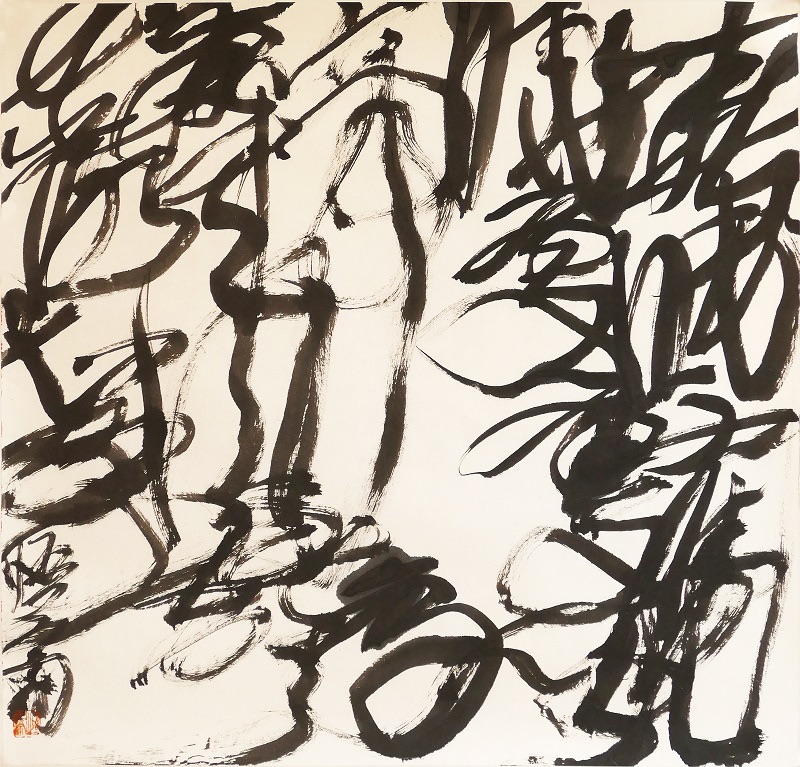Chaotic calligraphy
« previous post | next post »
In the middle of last month, I participated in a double book launch by Cambria Press in Singapore (links here, here, and here). The event was held at one of Singapore's most outstanding art galleries, called iPreciation (links here and here). This is what I saw as soon as I walked in the door:
Displayed against a plain, white background, this was the "grassiest" cursive calligraphy that I have ever encountered. The funny thing, though, is that, amidst the jumbled scrawl, I could pick out bits and pieces that I recognized. The reason is that it is one of my favorite Tang poems," Chūnxiǎo 春曉 (Spring Dawn)", by Mèng Hàorán 孟浩然 (689/691-740):
chūnmián bù jué xiǎo,
chùchù wén tíniǎo.
yèlái fēngyǔ shēng,
huā luò zhī duōshǎo
春眠不覺曉,
處處聞啼鳥。
夜來風雨聲,
花落知多少
Asleep in spring unaware of dawn,
And everywhere hear the birds in song.
At night the sound of wind and rain,
You'll know how much from the flowers gone.
Translated by Elling O. Eide
In The Columbia Anthology of Traditional Chinese Literature
The calligraphy is by Wáng Dōnglíng (b. 1945, Rudong, Jiangsu Province), a highly acclaimed contemporary Chinese calligrapher and ink artist. Wang calls this style "luànshū 乱书 (chaotic writing / calligraphy)" and says that is a great "túpò 突破 (breakthrough)" by him.
Wang is also famous for his public performances involving large format "kuángcǎo 狂草 (wild cursive)". Here are two photographs taken at Wang’s exhibition/public performance in Tai Miao/Forbidden City curated by Fan Dian:
As is evident in the first photograph, Wang literally dances when he does his "kuángcǎo 狂草 (wild cursive)". I find a large expanse of his "luànshū 乱书 (chaotic writing / calligraphy)" so captivating as to be almost hypnotic. Watching him in action, as in this video, one realizes that his is a highly kinetic art. It reminds me somewhat of films of Jackson Pollock painting, like this one.
iPreciation features Wang Dongling's work and has a number of other pieces by him on exhibit. The above video link includes an E-Catalogue.
For those who want to learn more about Wang Dongling, I have a copy of his CV and am willing to share it with others.



Allen Thrasher said,
August 6, 2018 @ 11:02 pm
I know about grass writing, but could one call this straw writing?
Philip Taylor said,
August 6, 2018 @ 11:23 pm
I am afraid that this smacks too much of "the Emperor's New Clothes" for my taste …
KeithB said,
August 7, 2018 @ 9:39 am
yoandri:
Not if you call it "Calligraphy" 8^)
Tom Davidson said,
August 8, 2018 @ 4:09 am
The monk Huai Su is my favorite grass script calligrapher. Anyone else in the Huai Su camp?
~flow said,
August 8, 2018 @ 8:30 am
@Tom Davidson
here! Absolutely love his 夢 dream character and printed it on a T shirt once…
John Rohsenow said,
August 9, 2018 @ 12:22 am
At first glance it reminds me of the "planchette"(?) writing done by possessed danggi spirit mediums in Taiwan, which only they themselves can then later interpret.
DMT said,
August 9, 2018 @ 3:34 am
Prof. Mair doesn't say whether he could read any "bits and pieces" of the script without knowing in advance that the text was the Meng Haoran poem. Personally, I would have found this impossible. But once I knew the underlying text, the individual characters started to emerge. (The part that took longest to figure out was the lower right-hand corner, where the second 處 and the 聞 crash into the 不覺.)
Once you have figured out what is what, it all makes sense: scrunching 處聞 towards the right creates an empty space in which the music of the "birds in song" reverberates, until it eventually reaches the poet's listening ears (as suggested by the linkage between 鳥 and 聞).
B.Ma said,
August 9, 2018 @ 4:47 am
@yoandri dominguez
It's not writing, really. It's art. Children (and adults) do get scolded for "bad handwriting" in Chinese too.
Not sure what sweatshops have to do with anything. As if the same things didn't happen in the US in the past, and do you really think that schools in China are a bastion of freedom?